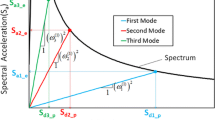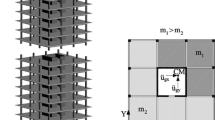Abstract
The pushover analysis (POA) procedure is difficult to apply to high-rise buildings, as it cannot account for the contributions of higher modes. To overcome this limitation, a modal pushover analysis (MPA) procedure was proposed by Chopra et al. (2001). However, invariable lateral force distributions are still adopted in the MPA. In this paper, an improved MPA procedure is presented to estimate the seismic demands of structures, considering the redistribution of inertia forces after the structure yields. This improved procedure is verified with numerical examples of 5-, 9- and 22-story buildings. It is concluded that the improved MPA procedure is more accurate than either the POA procedure or MPA procedure. In addition, the proposed procedure avoids a large computational effort by adopting a two-phase lateral force distribution..
Similar content being viewed by others
References
Bracci JM, Kunnath SK and Reinhorn AM (1997), “Seismic Performance and Retrofit Evaluation for Reinforced Concrete Structures,” Journal of Structural Engineering, ASCE, 123: 3–10.
Chopra AK (2004), Seismic Demands for Performance-based Engineering of Buildings, Keynote Paper No. 5007, Proceedings of 13th World Conference Earthquake Engineering, Vancouver, Canada.
Chopra AK and Chintanapakdee C (2003), “Evaluation of Modal Pushover Analysis Using Generic Frames,” Earthquake Engineering and Structural Dynamics, 32(3):417–442.
Chopra AK and Goel RK (2001), “A Modal Pushover Analysis Procedure to Estimate Seismic Demands for Buildings: Theory and Preliminary Evaluation,” PEER REP. NO. 2001/03, Pacific Earthquake Engineering Research Center, University of California, Berkeley, California.
Chopra AK and Goel RK (2002), “A Modal Pushover Analysis Procedure for Estimating Seismic Demands for Buildings,” Earthquake Engineering and Structural Dynamics, 31(3): 561–582.
Chopra AK, Goel RK and Chintanapakdee C (2001), “Statistics of SDF-system Estimate of Roof Displacement for Pushover Analysis of Buildings,” PEER REP. NO. 2001/16, Pacific Earthquake Engineering Research Center, University of California, Berkeley, California.
Chopra AK, Goel RK and Chintanapakdee C (2004), “Evaluation of a Modal MPA Procedure Assuming Higher Modes as Elastic to Estimate Seismic Demands,” Earthquake Spectra, 20(3): 757–778.
Elnashai AS (2001), “Advanced Inelastic Static (pushover) Analysis for Earthquake Applications,” Structural Engineering and Mechanics, 12(1):51–69.
Fajfar P (1999). “Capacity Spectrum Method Based on Inelastic Demand Spectra,” Earthquake Engineering and Structural Dynamics, 28:979–993.
Fajfar P (2002), “Structural Analysis in Earthquake Engineering — A Breakthrough of Simpified Non-linear Method,” Proceedings of 12 th European Conference on Earthquake Engineering, London.
Goel RK and Chopra AK (2005), “Role of Higher-mode Pushover Analysis in Seismic Analysis of Buildings,” Earthquake Spectra, 21(4): 1027–1042.
Gupta B and Krawinkler H (1999), “Seismic Demands for Performance Evaluation of Steel Moment Resisting Frame Structures,” Report No. 132, John A. Blume Earthquake Engineering Center, Stanford University, Stanford, California.
Gupta B and Kunnath S K (2000). “Adaptive Spectra-based Pushover Procedure for Seismic Evaluation of Structures,” Earthquake Spectra, 16(2): 367–391.
Krawinkler H and Seneviratna GDPK (1998), “Pros and Cons of A Pushover Analysis of Seismic Performance Evaluation,” Engineering Structures, 20(4–6): 452–464.
Kunnath SK and Gupta B (2000), “Validity of Deformation Demand Estimates Using Nonlinear Static Procedures,” Proceedings of the U.S. — Japan Workshop on Performance — Based Earthquake Engineering Methodology for R/C Building Structures, Japan.
Lawson RS, Vance V and Krawinkler H (1994), “Nonlinear Static Pushover Analysis — Why, When, and How?” Proceedings of 5 th U.S. National Conference on Earthquake Engineering, Chicago.
Reinhorn AM, Kunnath SK and Rodolfo Valles-mattox (1996), “IDARC-2D Version 4.0: A Computer Program for the Inelastic Damage Analysis of Buildings,” Technical Report NCEER-96-0010, National Center for Earthquake Engineering Research, Buffalo, N. Y., pp.1–120.
Sasaki KK, Freeman SA and Paret TF (1998), “Multimode Pushover Procedure (MMP) — A Method to Identify the Effects of Higher Modes in A Pushover Analysis,” Proceedings of 6 th U.S. National Conference on Earthquake Engineering, Seattle, WA.
Sun Jingjiang, Tetsuro Ono and Wang Wei (2003), “Lateral Load Pattern in Pushover Analysis,” Earthquake Engineering and Engineering Vibration, 2(1): 99–107.
Yang Pu, Li Yingming and Wang Yayong (2000), “A Study on Improvement of Push-over Analysis,” Journal of Building Structures, 21(1): 44–51. (in Chinese)
Ye Liaoyuan and Pan Wen (2000). “The Principle of Nonlinear Static Analysis (Push-over) and Numerical Examples,” Journal of Building Structures, 21(1): 37–43. (in Chinese)
Yin Huawei, Wang Meng fu and Zhou Xiyuan (2003), “Studies and Improvements on Structural Static Pushover Analysis Method,” Engineering Mechanics, 20(4): 45–49. (in Chinese)
Zhai Changhai (2005), “Study on the Severest Design Ground Motions and the Strength Reduction Factors,” PhD Thesis, Harbin Institute of Technology, Harbin, China.
Zhou Dingsong and LU Xilin (2004), “Application of Ductility Demand Spectra in Performance-based Seismic Design,” Earthquake Engineering and Engineering Vibration, 24(1): 31–38. (in Chinese)
Author information
Authors and Affiliations
Corresponding author
Additional information
Supported by: National Natural Science Foundation of China Under Grant No.50608024 and No.50538050; Opening Laboratory of Earthquake Engineering and Engineering Vibration Foundation Under Grant No.2007001
Rights and permissions
About this article
Cite this article
Mao, J., Zhai, C. & Xie, L. An improved modal pushover analysis procedure for estimating seismic demands of structures. Earthq. Eng. Eng. Vib. 7, 25–31 (2008). https://doi.org/10.1007/s11803-008-0786-y
Received:
Accepted:
Published:
Issue Date:
DOI: https://doi.org/10.1007/s11803-008-0786-y




